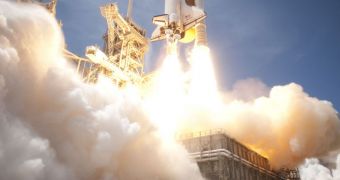Since the Columbia accident in 2003, the American space agency has put in place measures to ensure that something like this never happens before. As such, as space-bound shuttles need to inspect their own heat shield the first full day they spend in space. For Atlantis, that took place on Saturday, but the crew experience a problem with the sensor-laden pole that they were using to peer under their orbiter's belly and wings. The malfunction took hours to bypass, but NASA officials say it will not influence the overall outcome of the missions, Space reports.
All three operating space shuttles have very delicate heat shields. The protective structures are made up of numerous, smaller tiles, which need to fit into each other neatly, in order to ensure that the shuttle can endure the high temperatures it experiences upon atmospheric reentry. When Columbia took off, some of its heat shield tiles were damaged when debris fell from the shuttle's external tank. Days later, as it was returning from space, and attempting to reenter Earth's atmosphere, the high temperatures damaged the tiles even further, until the latter finally gave way. This eventually led to the orbiter and the crew being lost.
Currently, all shuttles need to undergo two heat shield inspections carried out by astronauts aboard, one carried out by the crew of the International Space Station (ISS), and others carried out by ground engineers. All the data are then centralized, and mission planners decide whether to allow orbiters to land, or if a new course of action is needed. As Atlantis astronauts were attempting to conduct their first heat shield inspection, they noticed that the primary camera used to make the observations was not functioning properly, generating readings that were deemed to be useless.
Eventually, the STS-132 crew got around this problem by replacing the main instrument with a back-up one. The problem itself was generated by the fact that a cable had become pinched in a section of Atlantis' hardware. The cable connected the shuttle's systems to the camera. On Saturday, Mike Sarafin said that the delay in the planned, six-hour-long inspection should have little to no bearing on the final outcome of the flight. Sarafin is the NASA STS-132 lead shuttle flight director.

 14 DAY TRIAL //
14 DAY TRIAL //